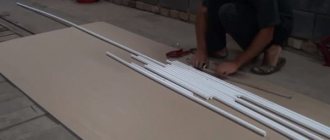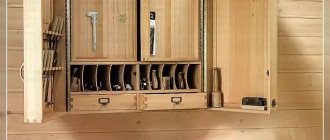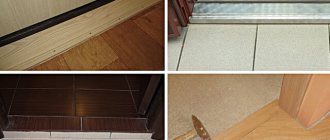The construction phase of the bathhouse is over, the time has come for its internal filling. And an integral attribute of the decor is its furniture, including benches. Because with their help, a cozy and comfortable environment is created and, in addition, it is the furniture that provides excellent opportunities for relaxation.
Furniture can be a variety of items, but a bath bench, made with your own hands, is one of the main ones, and also a reason for pride. The bench is one of the mandatory components of the bathhouse interior, but making it yourself is not difficult and, moreover, its price will be low.
>
Such benches in the rest room are very original
Making a bench for a bath
Wood selection
Oak is one of those materials that is not afraid of moisture
The bathhouse itself can be built from various materials, but the furniture is made only from wood.
And not just anyone, but one that meets certain requirements:
- A bench for the bath: do it yourself, it should be made from moisture-resistant wood with low thermal conductivity. Not every material can withstand high temperatures and humidity.
- Wooden benches must have an enviable resistance to cracking. In particular, an excellent bench for a bathhouse - made with your own hands, from oak, birch, linden, maple, aspen and poplar. Deciduous wood does not emit harmful resins, does not burn the skin, is easy to clean and dries quickly.
- All of the listed types of wood have ease of processing, a minimum number of knots and good density, that is, important advantages. Well, they have an excellent property that is inherent in all of the listed breeds, this is the content of useful substances that have a healing effect on the human body.
The best material for a bath bench
So, if you decide to take on all the hassle of making the bench yourself, you must first decide what type of wood it will be made from. The main criteria for selecting wood are moisture resistance , low thermal conductivity, density and hardness of the material.
A good choice would be boards made from deciduous trees - birch, oak.
It dries quickly, is easy to clean and practically does not release resins when heated, which means it is safe for health. Linden is also perfect. It is also easy to process, does not crack, heats up slowly, and at high temperatures releases a pleasant aroma. If finances allow, then you can use larch - it is an ideal option, but is quite expensive.
Types of bath benches
Benches for the washing room and rest room
On our portal you can find a large number of photos of various types of furniture such as a bench for a bath - made with your own hands. What is striking is that there are movable benches, suitable for a rest room, and fixed benches, necessary in such a section of the bath as a steam room.
A simple sauna bench without a back is most often used as a footrest. It’s easy to make such a mini-bench for a bathhouse; the question of how to make a bench for a bathhouse with your own hands is completely solved. Despite this, the most popular are the more practical models - two-tier or stepped benches, due to the fact that they do not get in the way and also save space.
Step-type benches are located vertically. The top shelf of the bathhouse should be wider, due to the fact that it is intended not only for sitting, but you can also lie on it.
Steam room benches
Two-tier benches are optimal for small baths and can be climbed using ladders. It happens that the steam room is very small, then in this case a wide bench-shelf of a removable type is a competent and thoughtful solution.
Drawings of a bench for a bath with your own hands will come to the rescue in determining the location and detailed indication of all such items of interior furnishings. If the bathhouse is spacious, then, without limiting yourself, stepped benches can be mounted in three tiers.
Assembly and production of components
Stand composition:
- Board – 3 pcs.
- Fasteners (rotation axis) – 4 units:
- Bolt M12x95 – 1 pc.
- Nut M12 – 2 pcs.
- Washer 12 – 2 pcs.
- Grover washer 12 – 1 pc.
- Frame side – 2 pcs.
- Longitudinal frame bar – 2 pcs.
- Jumper – 1 pc.
- Rotating fixing bar - 2 pcs.
- Holder – 2 pcs.
The footrest is assembled directly in the steam room in the following order:
- Attaching holders to the wall.
- Assembling the frame from parts 3, 4, 5.
- Fastening the frame to the holders using fasteners (see item 1).
- Attaching rotary fixing strips to the frame.
- Fixing the shelf in a horizontal position.
Making a bench in the bathhouse
The process of making bath furniture is largely based on imagination, although there are instructions that provide some standard actions. Let's start with something simple: a classic bench without a back.
A simpler bench
A simple bench for a washroom
Such a bench for a bathhouse is simple in its manufacture, due to the fact that it contains a seat, four legs, slopes and crossbars necessary to increase stability.
So, we determine the dimensions of the bathhouse bench with our own hands and get started:
- According to the dimensions, we cut the parts of the bench: a seat made of boards, legs, slopes and crossbars made of bars.
We measure the dimensions
- All parts are carefully polished to avoid splinters.
- We make spikes on the crossbars, and accordingly, grooves on the legs for their fastening.
- The crossbars are attached to the legs using glue, most often special wood glue is used, and using wooden nails. To do this, a hole is drilled through the leg and the tenon, slightly smaller in diameter than the nail, which is driven into this hole.
Tip: The material of the wooden nail should match the material of the bench parts. Otherwise, the nail may fall out of the hole and the bench will crumble.
- Using self-tapping screws, screw the seat. The heads of the screws are deepened into the board at a distance of about one centimeter, then these recesses are puttied.
The product is almost ready!
Attention: It is necessary to putty the recesses from the self-tapping screws, otherwise water will accumulate in them and the bench will deteriorate.
Bench for a bath in a steam room
When you need a drawing, with its help nothing will be missed in the work process and, in addition, you will save significant time. It is more convenient to work if you have a diagram at hand.
Shop layout: a little more difficult to execute
Before you make a bench for the bathhouse with your own hands, you need to prepare the material and tools. Materials include boards 50 mm thick, bars with a section of 50x50 mm, wooden nails or choppers, screws, thin planks.
The tools you will need are a screwdriver, a hammer, a grinder, sandpaper, a hacksaw, a plane, and a hammer.
- According to the diagram, parts are cut out, processed with a plane and polished until ideal smoothness is achieved.
- The frame is made using fasteners.
Assembling the frame
- Horizontal and vertical planes are sutured.
It may turn out like this
- Benches are mounted in several tiers. For ease of cleaning, the benches located at the bottom and top are removable, and those in the middle remain fixed.
Three-tier shelf in the steam room
Attention: It is not recommended to coat the structure with paint or varnish. When heated, they release substances that are harmful to humans, and they do not smell very pleasant.
What kind of bench should I set up?
When choosing which bench is best to put in the bathhouse, you need to start from the area of the steam room. If it is spacious enough, then the option of stepped benches is suitable, but if the area is not very large, then you can install two-tier benches. For very small steam rooms, one wide bench is usually chosen.
So, since the most common “tiered option”, we will describe the installation rules for it:
- The distance between tiers should be 1 meter;
- The lower benches should have dimensions of 90*50, and the upper ones - 180*60;
- From the ceiling to the benches you need to maintain a distance of at least 2 meters.
Shop parameters
Comfortable furniture is always adapted to the size of the human body. You won’t be able to have a good rest on a shelf or a wide banquette that is too narrow - it will be difficult to take a relaxed pose.
In order to design a shop, you should take into account its basic parameters.
Product height
The height of the bench is the distance from the floor or the previous step to the horizontal surface of the seat (from the floor to the knee plus 3–5 cm).
A bench that is too low strains your legs when standing up, and a bench that is too high is also uncomfortable - your legs don’t reach the floor
The height of the top shelf in the steam room is also regulated, but on the reverse side. The person standing next to you should not touch the ceiling of the bathhouse with their head; it should be comfortable to sit on the shelf. The upper shelf is located at such a distance from the lower ones that a person standing can hover with a broom lying on the shelf. If the step is too low, you will have to hold the broom at chest level - your hands will quickly get sore. If the step is too high, the bath attendant will bend and strain the spine.
Planting depth or width
The depth and width are determined by the functionality of the bench and its purpose
The seating product should not be too wide - about 30 cm. This is enough for a comfortable fit.
A massage bench or couch should be wider - 70–80 cm. A bench with a back rarely exceeds 50 cm - this is the distance from the knee to the back when sitting.
The shelf in the bathhouse must be quite wide - at least 80 cm. It is better to make it not from a solid panel, but from bars with a gap of 1 cm. This will allow better cooling of the body and allow excess moisture to drain.
Bench length
This parameter depends on the arrangement of furniture, layout and size of the bath itself.
The length of the shelf in the steam room should be 15–30 cm higher than the person. The bench in the wash room is selected based on the size of the room, which is usually limited. In order for a person to sit comfortably, the width of the product must be at least 40 cm.
In the rest room, the length of the bench is determined based on the number of seats: 90 cm for the first person plus 45–60 cm for each next person.
Benches for lying down should be longer than the one lying down, otherwise you won’t be able to get comfortable; the most successful are lengths from 1.7 m to 2 m.
The optimal size of the bench is selected strictly individually.
Using a tape measure, measure the most comfortable chair you have ever sat on, and use its parameters when making the bench.
Bath benches are a very useful and sometimes necessary attribute
The bathhouse cannot boast of a wealth of furniture; by and large, it is dominated by one permanently placed “king” - the canopy, which receives us during the entire time of visiting the bathhouse. Well, where to put the laundry in the dressing room, well, what if the canopy is high or you need to put a bucket of water in the steam room. That's when you can't do without a bathhouse bench.
You come to the need for this element of bath furniture gradually, often as a form of respect for such a place of relaxation as a bathhouse, which has already forced itself to be respected. But you must come.
You will have a bench for the bathhouse, and more than one - in the waiting room, necessarily and permanently, and in the washing room, most likely, for the time of use
A bench for a bathhouse with a high single-tier canopy will generally be necessary, just pay attention to the quality of the wood you choose - in the photo the craftsmen neglected this
Construction
To begin with, it is important to determine that a bench is one thing and a canopy is a completely different matter. Unfortunately, these two bath interior items are very often confused.
So, to avoid confusion:
- The canopy is a large bath bench from one wall to another, usually the larger one - the washing and steam room, on which the entire process of relaxation in the bath takes place. When you ask your bosom friend to walk over you with a birch broom, you will lie down on the canopy. Canopies are built in bathhouses in one, two or even three tiers.
- The shop is a completely different matter. In principle, you can also sit on it for bathing procedures, but this is both inconvenient and inappropriate, because there is a canopy. We will throw things on the bench in the dressing room, sit down there for tea, put a ladle or bucket of water in the washing room or steam room - the bench has a completely different purpose. In the end, the bench can always be moved to another location or even taken outside the premises.
The purpose is different, but the requirements are still very similar, as for the same canopies.
Wood
First, you need to choose the right type of wood from which the bench will be made. But let’s keep in mind that she doesn’t have to be in the room all the time, hence some nuances.
The following choices are possible here:
- Oak. The great flexibility and strength of this rock are very attractive for flooring and wall upholstery in bathhouses. The special structure of oak makes it very resistant to fungi, mold in the bathhouse and insects. But oak is quite difficult to process, at least it requires special and reliable tools. Oak boards are much more expensive than all others. I think choosing this breed for a shop is not a very wise decision.
Oak boards - a noble type of wood
- Linden. This breed has long been considered the most suitable for baths. A pleasant smell, low density, homogeneous structure, and hence ease of processing - everything suggests that you cannot find a better linden tree for a bench. It is also important that the surface temperature of such a bench will not depend on the ambient temperature; it will always be very comfortable.
- Aspen. An aspen bench, of course, will quickly lose color when exposed to moisture, but it will not dry out for a long time. The choice of aspen can be considered a good option if there is no other species at hand.
Aspen is a good option
- Alder. But alder is very suitable under any conditions. This is the same oak in its protective qualities, but it is much easier to process.
- Ash. What was said about alder can be confirmed for ash, but with an additional benefit - the color palette here is much softer and lighter, and this is the main argument for shops.
Simplicity of design, high-quality wood, fasteners that can withstand constant exposure to moisture, and careful manufacturing - what else is needed for a bathhouse bench to become an indispensable attribute in this vacation spot
- Cedar. This breed and all others related to conifers are strongly not recommended for use in steam rooms - the release of oils under the influence of high temperatures makes canopies from this species simply impossible to use, they turn out to be too hot. But benches don’t have to be kept in the steam room, especially not all the time. Therefore, feel free to use conifers that give such an unforgettable aroma for benches in bathhouses, including cedar. Another thing is that this breed is quite expensive.
- Larch. An excellent representative of conifers, in no way inferior to deciduous oak. Although this very strong breed also places special demands on the strength of the tool used.
- Pine. Perhaps the most used wood in baths. Pleasant smell, appearance, yes, resin, but for the bench this is often very unimportant, although remember this and keep the pine bench in the steam room as little as possible.
Pine products are the most popular
- Spruce. Easy to process, the most unprecedented textures, and the smell! Another thing is that it just so happened, most likely undeservedly and offensively for this breed, that it is rarely used for making benches. Well, you have the opportunity to please this breed with your choice.
Classification
In other words, when choosing wood for benches, if used wisely, choose any one from the proposed list. The main thing lies elsewhere, in its quality.
According to quality, wood is divided into 4 categories or classes:
- Extra class (or also “Premium”, or “Zero” - example “A”) - there is not a single knot or core of the original rock with an ideal uniform texture;
- Class “A” (example “B”) - only one knot per one and a half meters of length is allowed, perhaps no more than a couple of cracks and a small resin pocket; the color is still perfect;
The quality of wood is the determining criterion for choosing benches (see description in the text)
- Class “B” (example “C”) - the appearance is much worse - 4 knots per 150 cm, even through holes and noticeable stains are possible;
- Class “C” (example “D”) - there are already chips and cracks.
Thus, for benches it is best to choose “Extra” or “A” class wood. If you don’t mind the need to work a little to improve the visible quality of the shop, choose “B” for lack of a better one. Even in a desperate situation, you shouldn’t covet “C”. But here the matter is different.
The quality can be improved, but here’s how to cope with time, which is very merciless to these same bitches. They are the ones that will pose a problem in the future, and it is from them that the decay of wood begins. Therefore, after all, “Extra” and “A”, and no “nails”.
Helpful advice! By the way, I’m talking about nails, or rather the fasteners for the bench parts. Choose only galvanized fasteners, taking into account the extreme loads of temperature and moisture that the metal will constantly experience in the future. Rust shouldn't stand a chance.
Manufacturing
The entire process of solving the question of how to make benches for a bathhouse can be divided into two stages.
The first stage is preparatory
At the first stage:
- measurements are taken of the premises in which the bench is supposed to be installed;
- a drawing of the bench is made, broken down by detail - the product is simple, so there are no excuses for lack of thought and approximateness, everything must be strictly defined at the level of the drawing, including the fasteners used;
- The wood is prepared according to type and quality.
Here is a comprehensive drawing of a bench for a bathhouse - it practically eliminates all questions about the need for such help as instructions for making and assembling it yourself
Dressing room finishing
Finishing material
For a real Russian person, there is nothing better than wooden decoration, both in the bathhouse itself and in the dressing room. That is why wooden baths are so popular in our country. In addition, a bathhouse without the smell of wood, wooden benches and floorboards will seem uncozy and even alien to many. Therefore, even the owners of brick baths, instead of plaster and tiles, try to cover their walls and ceilings with clapboard. For finishing a steam room, lining made of coniferous species is suitable: pine, spruce, fir. And there is no need to be afraid that resin will ooze out of it; the temperature in the dressing room is usually comfortable enough to stay in, but it is not enough to “melt” the resin. The wood of these species has a pleasant smell and is even beneficial for human health. Birch can be used from deciduous trees. And if you want to surprise your guests, then you can use noble oak to decorate the dressing room.
Dressing room finishing photo
Furniture
The main furniture elements are, first of all, a strong bench, a table and a clothes hanger. These are, so to speak, the essentials in the dressing room. But to increase comfort, the bench can be replaced with a soft sofa upholstered in thick fabric. If you have enough space, you can buy a pair of wicker rocking chairs, and if you have extra funds, why not buy a massage chair in addition. Everything is done with an eye on the chosen interior style.
Dressing room finishing photo
Lighting
No bright sources or exposed light bulbs, although for a truly rustic style, a light bulb screwed into a wall socket will be the ideal solution. But a modern bathhouse should still provide comfort and encourage relaxation. Therefore, the lighting should be soft and at the same time quite sufficient. Since the dressing room is a less humid place, all types of lamps can be installed here.
By the way, it is strictly forbidden to use switches and sockets inside the washing room and steam room; all these electrical sources are placed in the dressing room.
Dressing room design photo
Traditional dressing room lighting is either a chandelier with a fabric or frosted glass shade or a pair of wall lights. And sometimes both together, if the waiting room is large. It is worth saying that such lamps can have lampshades made of wood that are traditional for a bath complex, as well as very original ones, as in the photo above.
If you can use a variety of materials to build a private bath, then it is better to make bath furniture, household items and accessories from wood.
A bench or bench for a bath is an important decorative and functional part of the interior. It is used in the steam room, washing room, relaxation room and even in the dressing room. The bench can be purchased ready-made or made independently from available material.
Detailed instructions for a portable bench
First, you need to write down the measurements of the future product, namely width, length and height. After which you should draw a drawing. The diagram should be convenient and understandable. Measurements can be indicated above the picture. For making a bench with your own hands, drawings are an important element.
Afterwards you need to decide on the location of the bench. It should be near the wall. There should be no windows nearby.
Necessary materials for work:
- two boards;
- planks;
- bars;
- self-tapping screw;
- screwdriver
All materials should be sanded first. After which the beams need to be cut into several parts for the legs and horizontal holders.
Make two frames. The legs and top posts should be fixed at the same height.
This video shows how to make a bench for a bathhouse with your own hands.
The boards should be installed one by one on the frames using self-tapping screws. There should be a space of one centimeter between the frames.
For better stability, two thin strips should be installed at the bottom.
The finished product should be coated with a special solution. At the same time, it must be environmentally friendly and not emit harmful substances. You can improve your results.










